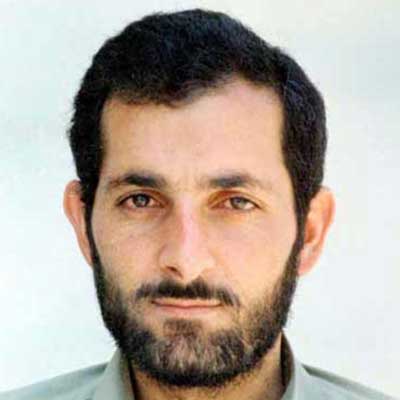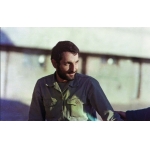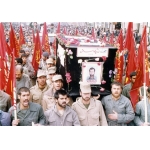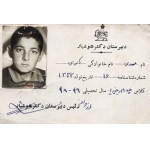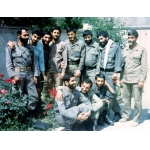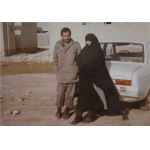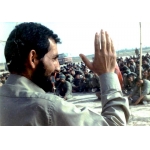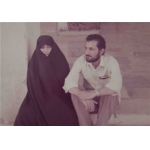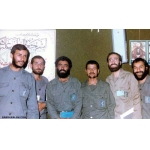Bakeri, Mahdi
Zeinab Ahmadi
932 بازدید
Mahdi Bakeri (1954-1985) the commander of the 31st Ashura Division of the Islamic Revolutionary Guard Corps (IRGC), was martyred during Operation Badr in Hour al-Azim.
Bakeri was born in Miandoab, West Azerbaijan Province. He began being politically active through encouragement of his brother, Ali, who was also martyred. In 1973, after graduating high school he was admitted into the University of Tabriz to study mechanical engineering. At university, he continued his political activities against the Pahlavi regime.
After graduating in 1977, Bakeri was drafted into the military and sent to the Farahabad Military Base in Tehran. In 1978, following Ayatollah Khomeini’s call for soldiers to desert their positions, Bakeri secretly returned to Urmia, where he participated in anti-regime demonstrations. After the victory of the Islamic Revolution in 1979, he joined the IRGC of Urmia and played a key role in organizing its early activities. He also served as the public prosecutor of Urmia. Later on, he became a member of the board of directors of Urmia’s Water Organization. Shortly after, he was appointed as the mayor of the city and on September 29, 1980, joined the Jihad of Construction (Jahad-e-Sazandegi) Council of the West Azerbaijan Province. About two months later, Bakeri joined the IRGC, again to participate in the liberation of Oshnavieh and border villages thereby taking command of military operations conducted in West Azerbaijan for seven months. In the meantime, he married Safieh Modarres on November 2,[1] 1980. In late 1980, Mahdi Bakeri and his brother Hamid left for Abadan to join the forces on the battlefront. There, they formed a small combat unit comprised of IRGC and local tribal forces. Later on, Bakeri returned to Urmia[2] to join the Jahad-e-Sazandegi to help the people in rural areas. For some time, he served as the commander of operations in IRGC of West Azerbaijan, focusing on liberating border villages from anti-revolutionary groups. Moreover, he participated in an operation conducted in Salmas, clearing the area from members of the Komalah. Finally, after seven months of fighting against the enemy in northwestern areas, he went to the south of the country.[3] In late 1981, Bakeri was appointed as the deputy commander of the newly formed Najaf Ashraf Brigade, which he formed with the help of Ahmad Kazemi. On March 22, 1982, Bakeri participated in Operation Fath al-Mobin. His ability to devise tactical plans and effectively implement them during the operation was particularly noteworthy. For instance, Bakeri along with the members of Jahad-e Sazandegi who had come from other cities managed to construct a military road between the eastern and western parts of the Mishdagh Heights. From there, the Iranian forces attacked the Iraqis through this road and paved the way for conducting future operations. In that operation, Bakeri led battalions and his eyes got injured.[4]
Bakeri continued his responsibility as deputy commander of the 8th Najaf Ashraf Brigade during subsequent operations, including Beit al-Muqaddas where he led two key battalions alongside Ahmad Kazemi. It was in this operation that Bakeri was injured again.
In June 1982, Mohsen Rezaee, the then Commander-in-Chief of IRGC, appointed Mahdi Bakeri as the commander of the 31st Ashura Brigade, which was comprised of IRGC and Basij forces from West Azerbaijan to conduct Operation Tariq al-Quds on November 29, 1981. On July 13, 1982, he led his brigade in Operation Ramadan which was launched near Basra. He got injured during this operation.[5] Bakeri also commanded the 31st Ashura Division in Operation Before the Dawn (February 1983). Moreover, the 31st Ashura Division led by Mahdi Bakeri[6] along with the 27th Muhammad Rasulullah (pbuh) Brigade led by Reza Cheraqi and the 10th Seyyed al-Shohada (as) Brigade led by Kazem Najafi Rastegar participated in Operation Valfajr 1 (April 1983) where he joined the group carrying out reconnaissance missions deep into enemy territory.[7]
In Operation Valfajr 2 (July 20, 1983) the 31st Ashura Division, under Bakeri’s leadership, achieved significant objectives, including the capture of the Haj Omran MilitaryBbase and cutting off key anti-revolutionary supply routes to Kurdistan.[8] Also, in the same year, the division participated in Operation Valfajr which aimed at securing the strategically important Shiler Valley.[9]
In addition, Bakeri commanded the 31st Ashura Division in Operation Kheibar[10] (February 22, 1984) during which his brother Hamid was martyred, but Bakeri refused to risk the lives of his forces to retrieve his brother’s body.[11]
After Operation Kheibar, Bakeri oversaw the construction of a new military base in Dezful, later named Shahid Bakeri Base, where the 31st Ashura Division was stationed.[12]
On March 11, 1985, the Iranian forces launched Operation Badr to capture the Basra-al-Ammarah highway and fulfill the unfulfilled objectives of operation Kheibar.[13] The 31st Ashura Division, led by Mahdi Bakeri, was the first unit to reach the western part of the Tigris River. On March 16, 1985, Mahdi was shot by a bullet to the forehead, and as he was being transported to safety, a mortar shell struck his boat, causing his martyrdom and the boat sinking in the river of Tigris. His body was never found.[14] A memorial grave for Mahdi Bakeri is built in the Martyrs’ Cemetery in Tabriz.[15] On September 27, 1989, Ayatollah Seyyed Ali Khamenei posthumously awarded the Fath Medal to some of the distinguished military commanders of the Iran-Iraq War including Mahdi Bakeri.
[1] Najafi, Hossein, Exemplars of Our Time: Hamid Bakeri, Morteza Yaghchian, Ali Tajalaei, Hassan Shafizadeh, Mehdi Bakeri, Tabriz: Foundation for Preservation of Works and Propagation of the Values of Sacred Defense of East Azerbaijan, 2005, pp. 8 and 9; Alaei, Hossein, Mehdi Bakeri in Thought and Action, Tabriz: Foundation for Preservation of Works and Propagation of the Values of Sacred Defense of East Azerbaijan, 2008, pp. 34, 35, 39, 42, 43, and 49.
[2] Alaei, Hossein, Mehdi Bakeri in Thought and Action, pp. 52, 53, and 157.
[3] Ibid., pp. 44-49.
[4] Ibid., pp. 54 and 55; Najafi, Hossein, The Role Models of the Enduring, p. 9; Doroudian, Mohummad, A Journey through the Iran-Iraq War, Vol. 1: Khonin Shahr ta Khorramshahr(From the bloody city to the peaceful city), Tehran: Center for War Studies and Research of the Islamic Revolutionary Guard Corps, 2008, p. 81.
[5] Alaei, Hossein, Mehdi Bakeri in Thought and Action, pp. 58-61.
[6] Rashid, Mohsen, Atlas of the Iran-Iraq War, Tehran: Sacred Defense Documents and Research Center of the Islamic Revolutionary Guard Corps, 2008, p. 70.
[7] Alaei, Hossein, Mehdi Bakeri in Thought and Action, p. 63.
[8] Rashid, Mohsen, Atlas of the Iran-Iraq War, p. 86. Najafi, Hossein, The Role Models of the Enduring, p. 8
[9] Rashid, Mohsen, Atlas of the Iran-Iraq War, p. 9
[10]. Alaei, Hossein, Mehdi Bakeri in Thought and Action, pp. 65-67.
[11] Ibid., pp. 155 and 66
[12] Ibid., p. 88.
[13] Ibid., p. 70.
[14] Ibid., pp. 79 and 80.
[15] Shahed Yaran, No. 157, November 2018, p. 15.


